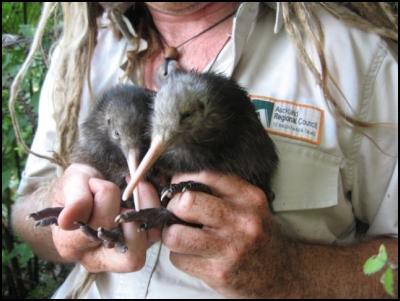First wild hatched kiwi chicks on Ak mainland
Tawharanui babes: photos of first wild hatched
kiwi chicks on Auckland mainland in 60
years
16 January 2009

More kiwi chicks
have hatched at Tawharanui Open Sanctuary indicating that
this newly established population is thriving. Photographs
confirm that Tawharanui is home to the first wild kiwi to
hatch on the Auckland mainland for 60 years.
Two chicks were discovered yesterday (Thursday 15 January 2009) during routine monitoring by open sanctuary coordinator Matt Maitland, and rangers Mark Pengelly and Lois Clayton.
Matt says that the news of more kiwi chicks at Tawharanui is heartening.
“We are well on our way to our goal of establishing a self sustaining kiwi population which can in turn help establish new sites, like the planned Shakespear Open Sanctuary at Shakespear Regional Park.
“The ongoing work of TOSSI volunteers and ARC staff who monitor the integrity of the pest proof fence, maintain the sanctuary’s pest free status and monitor these kiwi is essential to this success,” he says.
Dr Hugh Robertson of the Department of Conservation's Kiwi Recovery Group was delighted to hear that brown kiwi have bred successfully in North Auckland for the first time in over 60 years.
“The birds released at Tawharanui were part of the Bank of New Zealand Operation Nest Egg programme being run in Northland, and included several offspring from the seven radio-tagged adult kiwi killed by dogs near Whangarei just before Christmas.
“This good news balances the earlier sad news, and highlights the importance of predator control in government and community efforts to save our national icon.
“I hope that this is just the start of a florishing population behind the predator-proof fence at Tawharanui, and that we will soon be forced to look for more mainland release sites within easy reach of Auckland as this population expands rapidly,” he says.
“This brings our new additions to four – that we know of,” says Matt.
“We have purposely let the birds ‘get on with it’ and not gone searching for burrows or disturbed the areas where ‘egg timer’ radio transmitter signals are coming from. We knew that Geo had been sitting on a nest and were lucky enough, during a planned transmitter change, to come across these two chicks in the burrow and spend some time finding out about them.
“By keeping interference to a minimum we can be confident that our predator-free environment is suitable for a breeding population of kiwi.”
‘Egg timer’ radio transmitters were fitted to some of the male birds before they were released into the open sanctuary over the last two years. This allows monitoring of the birds’ movement from afar and gives park staff and TOSSI volunteers a good indication of how the population is faring in the wild. This planned radio transmitter change had been delayed until incubation activity had ceased.
Male kiwi take care of the nest and incubate the eggs. There are 19 males not radiotagged, so their breeding status is unknown.
“We should assume that there are more unknown chicks out there,” says Matt.
The sex of the two newly discovered chicks is as yet unknown. At this early stage in their life DNA testing, from the young birds’ feathers, is the only way to find out whether they are male or female. The age of the birds is estimated to be between one and three weeks old and they weigh 320g and 380g each, probably a little more than their egg and hatch weights.
The chicks’ father, Geo, is a male that was transferred to Tawharanui in November 2007 from Motuora Island as part of the Operation Nest Egg programme. This is Geo’s second clutch of eggs, he had a presumed successful nest hatch (one egg) in September last year. Two eggs per nest and two nests per year is not uncommon for a North Island brown kiwi once it reaches maturity.
“We have one more known nest due to hatch very shortly. Hercules, who also bred successfully in 2007, has been giving an incubation activity signal recently,” says Matt.
A population survey is planned for 4-5 years time whereby the proportion of known to unknown individual birds will give an estimate of population growth.
The Tawharanui Open Sanctuary, at Tawharanui Regional Park near Warkworth, was officially opened in March 2006 and is the result of a pest eradication programme, replanting regime and vital partnership between the ARC and TOSSI.
ENDS
For further information about the Tawharanui Open Sanctuary Society Inc (TOSSI) go to www.tossi.org.nz
Forty-four kiwi have been released into the Tawharanui Open Sanctuary in the last two years.
Fifteen kiwi were released in November 2006, signalling the return of North Island brown kiwi to the Auckland mainland for the first time in around 60 years.
Another 25 kiwi were released in November 2007.
Four females were added in late 2008 to address a gender imbalance in the population.
All birds are raised via Operation Nest Egg from wild Northland stock.


 Vegetables New Zealand: New Web-Based Tool Will Help Greenhouse Growers Switch To Geothermal Heating
Vegetables New Zealand: New Web-Based Tool Will Help Greenhouse Growers Switch To Geothermal Heating Horizon Research Limited: New Poll - New Zealanders Prefer Rail Enabled Ferries
Horizon Research Limited: New Poll - New Zealanders Prefer Rail Enabled Ferries Watercare: Watercare Gets To Work On First Permanent Non-Potable Water Tanker Filling Station In Māngere
Watercare: Watercare Gets To Work On First Permanent Non-Potable Water Tanker Filling Station In Māngere Alcohol Healthwatch: Licensing Decision Lauded For Prohibiting Buy Now Pay Later Schemes In Bottle Stores
Alcohol Healthwatch: Licensing Decision Lauded For Prohibiting Buy Now Pay Later Schemes In Bottle Stores Motor Industry Association: Vehicle Registrations Up 5.6% In December, But Year-To-Date Sales Reflect Market Challenges
Motor Industry Association: Vehicle Registrations Up 5.6% In December, But Year-To-Date Sales Reflect Market Challenges BNZ: Depression-era Bequest Still Helping 88 Years Later
BNZ: Depression-era Bequest Still Helping 88 Years Later



